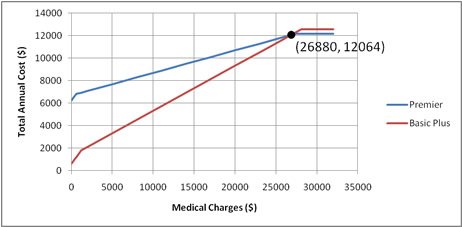
In a previous post, I described a choice I had to make regarding health insurance during the summer. In short, I needed to choose between a high premium/low deductible plan and a low premium / high deductible for my family. The analysis I completed on the two plans led me to a new project for College Algebra students.
To present the components of the project, let me explain my thought process in developing the project. The goal of the project is to have students develop models for two medical insurance plans of their choosing and to compare them. The models should give the total annual cost of each plan to the insured as the total medical charges increase. With these models they construct a graph to compare the plans like the one below.

Based on the graph, students can make a choice of the two insurance plans based on their own lives. As a template, I lead them through a potential solution using the information from my two health plans, the Basic Plus Plan and the Premier Plan. They will need to follow the same strategy with two plans of their own choosing.
This means the first task they need to accomplish is selecting two health plans. The technology assignment
Technology Assignment : Collect and Organize Data (PDF)
is customized to their unique data (state, age, dependents). This accomplishes one of my requirements of projects. Each student does a unique project based on the theme of comparing health plans.
Once they have this information in hand, they use Excel to document their plan. The primary goal of using Excel in this assignment is to get them familiar with the interface and to demonstrate how to format cells. Later assignments utilize Excel’s capabilities more fully.
A sample submission for the technology assignment
When I grade the assignment, I make sure that they have at least given me the most basic information about their plans such as copays, coinsurance, deductibles and out of pocket maximums.
I used this assignments this semester and students had little trouble completing it. There were many comments in class about why some plans are cheaper than others. I was surprised at how many students were completely ignorant about how insurance works. I guess I should not be too surprised since my classes are mainly 17 to 21 year olds with a handful of older students. Opening their eyes to the important issues and terms regarding healthcare was very satisfying.
In my next blog post I’ll talk about the second technology assignment I give students. In this assignment they make a table of increasing medical charges and the corresponding costs to the insured.












